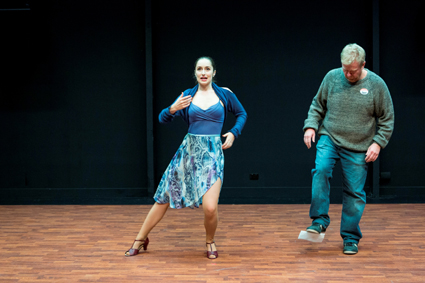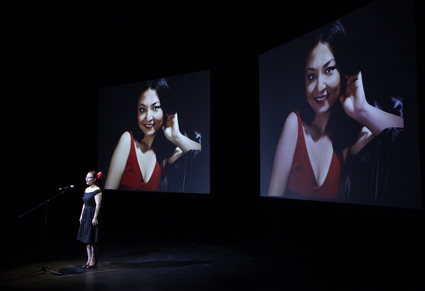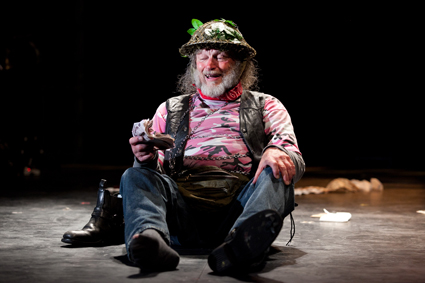Intimacies & vulnerabilities
Keith Gallasch, Dance Better At Parties, Stories Then & Now, Henry 4

Elizabeth Nabben, Steve Rodgers Dance Better at Parties, Sydney Theatre Company,
photo Brett Boardman
Elizabeth Nabben, Steve Rodgers Dance Better at Parties, Sydney Theatre Company,
The intimacy of Gideon Obarzanek’s production of his Dance Better at Parties, its structure a series of one-on-one dance classes, acutely highlighted the emotional vulnerability of his protagonists. William Yang and Annette Shun Wah’s Stories Then and Now frankly delineated the lives of six people of migrant background, each telling their own story with the intimacy of direct address while opening out rich cultural and historical perspectives. Bell Shakespeare’s Henry 4 was, of course, bracingly epic but it compellingly foregrounded desperate attempts to maintain or establish emotional kinship.
Dance Better at Parties
Dance Better at Parties is a gentle, lucidly constructed parable from Gideon Obarzanek, Associate Director at the STC in 2012, about guilt, grief and emotional transference.
Dave (Mark Rogers), a shy man in early middle age seeks out a dance class, simply, it seems, so he can “dance better at parties.” He hesitates when confronted with a choice of seemingly complex styles but then enrols, persuaded by his young teacher-to-be, Rachel (Elizabeth Nabben), who is deft at delivering a charming pitch by rote (we hear her later on the phone uttering the same to another potential client).
The otherwise sincere Rachel eventually overcomes Dave’s reticence with some very determined instruction, one of the production’s several key pleasures since the teaching, elaborated in convincing detail (right from how to walk), is central to the grieving Dave’s emotional recovery from the death of his wife, loosening his body, standing him tall, imbuing elegance and reigniting desire. Rachel perhaps more than likes Dave, but is shocked, as is the audience, when he secretly films her—the outcome is violent. In one of the play’s odd gaps we’re left uncertain as to why she then continues teaching him, or even how his return to class was negotiated. The relationship warms, Dave’s skills improve considerably, evident in the pair’s joyous dancing in the final lesson. However Rachel doesn’t turn up to partner Dave at the school’s end of course party. His disappointment brief, he seeks out another partner with his new-found confidence. Without her saying it in the previous scene, we can see in the lone Rachel the weight she has taken on and the artificiality of a relationship without foundations. It’s a simple but effective tale that nicely sidesteps sentimentality.
The taut framework of the narrative is provided by the strict time limits enforced by the dance sessions, teasingly leaving words unsaid and desires held in check. Above all the performances are engagingly quiet in a city where small theatre spaces flood with overly forceful projection. Rogers (his Dave ungainly, initially slightly stooped, hesitant, growing in confidence) and Nabben (her Rachel confident, playful, an eager teacher, but emotionally alert to her own needs) are subtle performers who find an abundance of nuance in a spare script built from interviews Obarzanek made with dance class students (oddly no one is credited with writing Dance Better at Parties). The spare set (design Renee Mulder)—wide parquet floor, cupboard, table, chair and, in the end, a celebratory golden curtain—underpins the overall simplicity of the directorial approach, allowing the underlining of small complexities, while the spare fluoro lighting amplifies the production’s intimate realism, save for those scenes that step out of the ordinary with alarming colour (design Benjamin Cisterne). Jessica Prince’s choreographing of the teaching techniques and the dancing provides Obarzanek with physical theatre opportunities rich in comic missteps, intimacy and display.
All Dave wanted to do was “dance better at parties,” but he goes much further than that in a play that is as funny as it is sad. Dance Better at Parties first appeared, if from the same impulse but in a very different shape, in 2004, with five interviewees on video screens, their stories realised, quite unliterally, by five dancers. It’s somewhat surprising to see the creator of Glow, Mortal Engine and other demanding multimedia works turn his hand to simple, social drama in this work’s latest manifestation, but the seed was there in the original work, and is also evident in his co-directed 2007 film Dance Like Your Old Man. It’s still about dancing. Now as part of the South Australian Film Corporation’s HIVE Lab, Dance Better at Parties is set to become a film (RT111. p25).
Stories Then & Now

Willa Zheng, Stories Then & Now
photo Susannah Wembley
Willa Zheng, Stories Then & Now
Six people step in turn before a microphone, framed by large projections of photographs drawn from the family history of each on two large screens. Their unrushed delivery, careful pacing and spare storytelling is unmistakably in the manner of the well-known performances by their workshop leader, the photographer William Yang. Like Yang, they have recalled, reflected on and distilled personal histories to make sense of their uncertain identities as migrants at the nexus of at least two cultures—sometimes more. Academic Ien Ang spoke of an ethnic Chinese childhood in Java, growing up in the Netherlands (a stormy adolescence) and then finding a career in Australia, love with an English archaeologist and a home away from home in the south of France where the different strands of the family can come together.
Stories Now & Then, directed by Yang and Annette Shun Wah, is a gentle, undemonstrative show, yielding the kind of pleasure that comes from being read to aloud. Here however, the six largely non-professional performers had learned their lines, if not always comfortably; only a couple were able to relax sufficiently to significantly vary pace and tone. Not that this really mattered, we didn’t expect them to act. But I was concerned for their vulnerability, centrestage in a large theatre, with a sizeable audience and big projections. I wondered why, save for theatrical neatness, the speakers all had to present in exactly the same formal way.
That concern aside, the frank tales these brave speakers told were culturally and historically intriguing, each very different from the other but with a middle class commonality—born into, lost and found again, or, from humbler origins, newly achieved. Ideological, religious, cultural and generational tensions dominated the stories, sometimes amusingly, now and then darkly as the lives of the speakers moved from social and political restraint to independence, if often without quite resolving relationships with their parents. However, their concern for grandparents and parents (caught, for example, in the conflict between Communism and Nationalism in the late 1940s; talented women denied full education; a scholar blacksmithing for seven years in a village during Mao’s Cultural Revolution; a career in Indonesia ruined by the 1967 coup) is recurrently evident, alongside blunter revelations about abandonment or a funny but telling tale about an unlikely (and thwarted) arranged marriage in very recent times.
These stories are of a kind that many Australians are unlikely to hear or are only told within family circles. Occasionally they make it to radio, rarely to film or television. They are necessary fuel for developing empathy and for an understanding of what Australia has become. Ien Ang, Jenevieve Chang, Michael CS Park, Sheila Pham, Paul van Reyk and Willa Zheng perform courageously—their openness about their lives is a welcome gift. It’s fascinating that not a few recognised the irony that the often appalling disruptions to the lives of their forebears and, for some, themselves have in part yielded the lives they now enjoy.
Bell Shakespeare, Henry 4

John Bell, Henry 4, Bell Shakespeare Company
photo Lisa Tomasetti
John Bell, Henry 4, Bell Shakespeare Company
Adapted by John Bell from Henry IV parts 1 and 2 and inventively directed by Bell with Damien Ryan, Bell Shakespeare’s Henry 4 was an exhilarating three hours of theatre. While the bovver boy and suits mix seemed at first a tad dated it stood up well to the test of conveying a sense of a mediaeval England that was in little way national, except when opportunism or crude xenophobia required it—as when the lads sang a punk anthem rendering of “Jerusalem.” A giant wall of plastic crates across the back of the stage (design, Stephen Curtis) gave the first sign of the fragile state of Henry IV’s England when it was broken through, an image reinforced by the yellow and black OH&S markings across the floor and a staging that could transform with the trundling of a juke box from one point to another and the stark delineations of place and mood generated by Mark Scott’s dynamic lighting.
Above all, this production made great sense of the play’s comedy, not only in its knockabout robustness, but also its constant revelations of hypocrisy and cruelty, not least in the ‘conscription’ scene where Falstaff (John Bell), Shallow (Sean O’Shea) and Silence (Arky Michael) compel unfit workers into the military and, for bribes, allow others off.
As ever, it’s the wordplay that crowns the comedy (aided by an abundance of apt topical references) but inventive physical manifestation and adroit timing bring it off. This is also comedy that at time runs close to pathos as we witness Falstaff’s stumbling attempts to back away from errors that put him at odds with his beloved Prince Hal (Matthew Moore). At other times his self-correction adds insult to injury, as with his cruel judgments of and then inept apologies to Mistress Quickly (Wendy Strehlow) and Doll Tearsheet (Matilda Ridgway).
Bell is superb as Falstaff, fat, grinning, wobbly on his pegs, a raging wit, deviously mercurial but rarely understanding the damage he is doing to himself in a world in which he attempts to stop the clock, imagining that whatever he does, the bond with Hal will be sustained. It’s a finely tuned performance, at once richly idiosyncratic and integral to the production’s ensemble playing, which includes an excellent Bardolph (Terry Bader), a fine Poins (Yalin Ozucelik), a vigorous and sensitive Mistress Quickly and a battered, emotional Doll Tearsheet, all of whom deliver much more than comedy. I admired David Whitney’s Henry IV—the aplomb of an assured businessman a veneer barely hiding the king’s anxieties. I was less sure of Matthew Moore’s much-praised Hal—too detached, too knowing, tonally dull. His rejection of Falstaff appears to be set in stone from the beginning. But in the run of things, this didn’t matter too much when it came to the ‘death’ scene between Hal and Henry where Moore revealed a more complex response to his father, and realpolitik—that’s in the writing and he did it justice.
Sydney Theatre Company, Dance Better at Parties, Wharf 2, 9 April-11 May; Carriageworks, Performance 4a, Stories Then & Now, Carriageworks, 22-25 May; Bell Shakespeare, Henry 4, Drama Theatre, Sydney Opera House, 24 April-26 May
RealTime issue #115 June-July 2013 pg. 40-41






